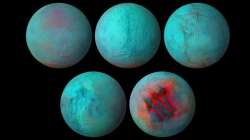Saturn's moon Enceladus has ice churning, landscape surfacing. Read on
Researchers have discovered that most of the ice over the Enceladus is fresh, according to the latest infrared images released by NASA. This discovery suggests that there might be global internal activity resurfacing the moon.

Researchers have discovered that most of the ice over the Enceladus is fresh, according to the latest infrared images released by NASA. This discovery suggests that there might be global internal activity resurfacing the moon.
In 2005, Saturn probe Cassini discovered plumes of salty water shooting out of four huge parallel chasms in the moon's south pole, nicknamed the "tiger stripes". Cassini went on to map over 100 geysers in the tiger stripe fractures.
According to Sciencealerts.com, these fractures are generated by tidal forces on the moon as it makes its eccentric orbit around Saturn. The planet pulls and stretches Enceladus, giving rise to internal heating and geothermal activity, and creating cracks in the surface ice at the south pole.
The geysers spew out water from the interior, kept liquid by the internal heating; this water sprays over the surface and freezes, creating a new layer of ice.
So, in infrared images from newly reanalysed data generated by Cassini's Visual and Infrared Mapping Spectrometer (VIMS) - the spacecraft's mission ended in September 2017, but its legacy lives on - it was to be expected you'd find light consistent with fresh ice, reflecting off the region around the tiger stripes.
Since such activity is likely related to seafloor hotspots, and such hotspots are likely to have a lifespan of only a few million years, that allows us to infer the age of the surface in these regions.
"The infrared shows us that the surface of the south pole is young, which is not a surprise because we knew about the jets that blast icy material there," said astronomer Gabriel Tobie of the University of Nantes.
"Now, thanks to these infrared eyes, you can go back in time and say that one large region in the northern hemisphere appears also young and was probably active not that long ago, in geologic timelines."
The team plans to apply their analysis techniques to data obtained in the upcoming Juice and Europa Clipper missions, to see what they can learn about Jupiter's icy moons Ganymede and Europa.
The research has been published in Icarus.
